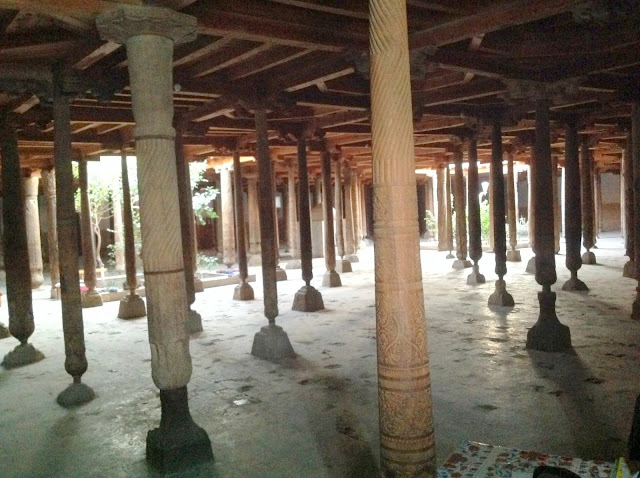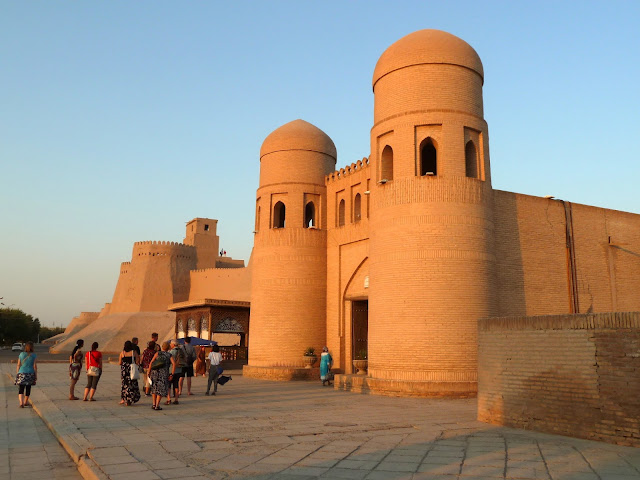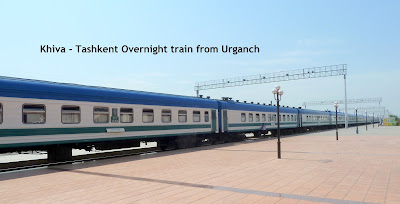Of all the cities
and towns visited by us during this tour, we fell in love with Khiva. It was so
serene and isolated that whilst there were some tourists, we felt comfortable, without
being hassled by local vendors or anybody else. It is a compact town.
It is wonderfully laid out. But more on that later.....Khiva's historical names include Khorasam, Khoresm, Khwarezm, Khwarizm, Khwarazm, Chorezm - it is a town in Xorazm Region. According to archaeological data, the city was
established in the beginning of the Christian era. It is the former capital of Khwarezmia and the Khanate of Khiva. Itchan Kala in Khiva was the first site in Uzbekistan to be inscribed in the World Heritage list 1991. The origin of the name Khiva is unknown.
 |
| This was the type of countryside most of the way -- desert and arid |
We went to Khiva from Bukhara which is a
long drive. 455+ kms – we left Bukhara at 8.00 am and reached Khiva at 3.40 pm; tired
but excited to be here.
“In the early part of its history, the inhabitants of the area were from Iranian stock and spoke an Eastern Iranian language called Khwarezmian. Subsequently the Iranian ruling class was replaced by Turks in the 10th century A.D, and the region gradually turned into an area with a majority of Turkic speakers.
The city of Khiva was first recorded by Muslim travellers in the 10th C, although archaeologists assert that the city has existed since the 6th C. By the early 17th C, Khiva had become the capital of the Khanate of Khiva, ruled by a branch of the Astrakhans, a Genghisid dynasty ".
"General Konstantin von Kaufman launched an attack
on the city, which fell on 28 May 1873. Although the Russian Empire now
controlled the Khanate, it nominally allowed Khiva to remain as a
quasi-independent protectorate.
Following the Bolshevik seizure of power after the October Revolution, a short lived Khorezm People's Soviet Republic was
created from the old Khanate of Khiva, before its
incorporation into the USSR in
1924, with the city of Khiva becoming part of the Uzbek Soviet
Socialist Republic”.
 Khiva is actually built in two sections
- outer town, called Dichan Kala had earlier a wall with 11 gates. The inner
town known as Itchan Kala is
encircled by brick walls whose foundations are believed to have been laid in
the 10th C. The walls that we see today date back to the late 17th
C and are 10 metres tall.
Khiva is actually built in two sections
- outer town, called Dichan Kala had earlier a wall with 11 gates. The inner
town known as Itchan Kala is
encircled by brick walls whose foundations are believed to have been laid in
the 10th C. The walls that we see today date back to the late 17th
C and are 10 metres tall.Our hotel was in the old town near the main street.
The Minaret of Kalta Minor seems to be the real symbol of the city due to its size and unique design. The foundation of the minaret is 15 metres, diameter at the foundation is 14.5 metres and its height is 29 metres. But this massive tower has only third part of the project height.
In 1855 the ruler Muhammad Amin Khan was killed and the construction of the magnificent minaret was stopped, though it was supposed to be of 70 metres. According to the architect, the wide foundation was to increase durability and the supposed top was to be narrower to decrease the load. But fate decreed otherwise – and the tower remained unfinished. And now it resembles a beautiful huge glazed barrel : called Kalta-Minor that means “short minaret”.
The old town retains more than 50 - 60 historic monuments and 250 old houses, mostly dating from the 18th or the 19th
centuries. Djuma Mosque, for instance, was established in the 10th century and
rebuilt in 1788-89, although its celebrated hypostyle hall still retains 112 columns
taken from ancient structures.
Khiva is
a most unusual Uzbek city. Its history is inextricably connected with
the history of the legendary Khorezm Shah’s State with its capital in Urgench
earlier. Khiva is a very ancient city. In the 10th century Khiva is
mentioned as a major trading center on the Silk Road. All the caravans had
a stop here on their way to China and back. From dawn to dusk, until the
gates were opened, an endless stream of moving string of camels with baggage
passed them.
At the beginning of
the 16th C, Khorezm State became home for Uzbek nomadic tribes, who
founded the Khive Khanate. However, Khiva did not become immediately the
Khanate’s capital. It happened only after Urgench, an existing capital, had
been destroyed due to the change of Amu Darya’s water channel changing direction. In 1598 Khiva
became the main city of the state.
The clay wall - more
than 2 km long, up to 10 m and 5-6 m at thickness - that surrounds the city of
Itchan-Kala, has four gates - on each corner of the earth. Western Gate -
Ata Darwaza. Gate Bagci leads to Urgench, the former capital of Khorezm,
Gate Palvan open the way to the Amu Darya and then in an easterly direction,
and the gate "Tash" - in a southerly direction.
 In Itchan-Kala there
are about 60 historic buildings. Here one can see such unique monuments of
history, as the citadel complex Kunya-Ark, the complex of Tash Hauli Palace,
the minaret of Caltha Minor that is completely covered with glazed tiles,
famous Juma Mosque with its 213 carved pillars, a symbol of Khiva Islam-Khoja
minaret, etc.
In Itchan-Kala there
are about 60 historic buildings. Here one can see such unique monuments of
history, as the citadel complex Kunya-Ark, the complex of Tash Hauli Palace,
the minaret of Caltha Minor that is completely covered with glazed tiles,
famous Juma Mosque with its 213 carved pillars, a symbol of Khiva Islam-Khoja
minaret, etc.
If blue domes are the
symbol of the eastern architecture and prevalent everywhere in Bukhara and Samarkand, there is only one blue dome in Khiva. It decorates the tomb of
Makhmud Pahlavan, a famous poet and warrior of the XIV century. There are many legends about his strength and courage. One of the legends tells that
Pahlavan conquered the Indian ruler, and the latter agreed to reward him with
whatever the hero would wish. Then Pahlavan Makhmud said: "Release my
countrymen from prison." And when the ruler asked how many
people he should release, Pakhlavan told all those who would fit into a
cow skin. He cut the skin into thin strips, tied them into one large belt
and wrapped all the prisoners with the belt. So Makhmud rescued many people
from slavery. After his death Muslim clergy canonized him.
 The complex was built only in 1701, according to the inscription on the stone gates. The dome of the mausoleum is covered with blue glazed tiles with glittering gilt top. Originally, the mausoleum was small and modest, but it quickly became a pilgrimage site with a lot of hujras, khanakas and mosques. The walls of the mausoleum are decorated with magnificent majolica. In the mausoleum of Pahlavan Mahmud people pray and drink the holy water
The complex was built only in 1701, according to the inscription on the stone gates. The dome of the mausoleum is covered with blue glazed tiles with glittering gilt top. Originally, the mausoleum was small and modest, but it quickly became a pilgrimage site with a lot of hujras, khanakas and mosques. The walls of the mausoleum are decorated with magnificent majolica. In the mausoleum of Pahlavan Mahmud people pray and drink the holy water - Ak Mosque
- Allakuli Khan Madrasah
- Arab Muhammad-khan Madrasah
- Dishan-kala hospital
- Djuma Mosque
- Islam Khoja complex
- Itchan-Kala
- Kalta-minor Minaret
- Khoja Berdibai Madrasah
- Kunya-Ark Citadel
- Mausoleum of Makhmud Pakhlavan
- Muhammad Amin-khan Madrasah
- Muhammad Rahim-khan Madrasah
- Sayid Allauddin Mausoleum
- Shergazi-Khan Madrasah
- Tash-Khovli Palace

Trade has flourished
at the gates of Pahla-van-darvaza. Small street-stalls
sell food and have always been there. In 1830's, by Alla-Kuli-khan's order, a
caravanserai was built and goods were brought here by caravans from
many countries. The planning of the
caravanserai is simple and comfortable. It is a symmetrical rectangular
building with a yard, on the perimeter of which there are two-story vaulted
rooms. Traditionally a portal separates the exit and level of the yard is
lowered in the center, which was comfortable for unloading of beasts of burden.
Merchants stayed here and goods were kept and traded here.
Close to the main
facade, oriented to the south, a covered bazaar (tim) was built; now the tim
and caravanserai constitute one area. The covered bazaar is a multi-cupola
composition stretching along a west-east axis. There is a hall in the center
leading to the caravanserai. The trading is conducted on the side stalls. In
earlier centuries one could buy goods brought from China, England and Bukhara
Khanate.

The famous Khiva masters Abdulla Jin and Ibadulla did the majolica facing of the mosque. The ceiling of the aivan is painted with elegant golden patterns on the blue background.
 One evening a group of young men and a beautiful lady entertained our group to a session of Uzbek dancing with local instruments.
One evening a group of young men and a beautiful lady entertained our group to a session of Uzbek dancing with local instruments. 

The fortress
 constructions were closely compacted together; their charm can be seen
in the yards with their splendid aivans. The high two-column aivan of the
kurinishkhana, where receptions were held, completely is faced with majolica.
In the eighteenth century during the devastating invasion of the Iranian troops
many constructions of the citadel were destroyed, and the kurinishkhana was
damaged. At the beginning of the nineteenth century Iltuzar-khan renewed it.
There was a throne-hall, khan's apartments, treasury, and manuscript
depository. The cold blue-white and sky-blue patterns of the majolica plate
contrast with the red murals of the ceiling. The Khiva masters arranged
ornaments freely and picturesquely. The interior of the throne-hall is
decorated with carved plaster. The throne was made of turned wood, decorated
with stamped silver. The local master Mukhammad made it in 1816.
constructions were closely compacted together; their charm can be seen
in the yards with their splendid aivans. The high two-column aivan of the
kurinishkhana, where receptions were held, completely is faced with majolica.
In the eighteenth century during the devastating invasion of the Iranian troops
many constructions of the citadel were destroyed, and the kurinishkhana was
damaged. At the beginning of the nineteenth century Iltuzar-khan renewed it.
There was a throne-hall, khan's apartments, treasury, and manuscript
depository. The cold blue-white and sky-blue patterns of the majolica plate
contrast with the red murals of the ceiling. The Khiva masters arranged
ornaments freely and picturesquely. The interior of the throne-hall is
decorated with carved plaster. The throne was made of turned wood, decorated
with stamped silver. The local master Mukhammad made it in 1816. This is an example of the beautiful tile work even though its slightly damaged.
The Khiva aivans were unique with their elegant decoration. Through skilful carving, stone carving, and decorative ceramics the artists and architects of Khiva expressed their notion of beauty.

At Urgench station, which is some distance from Khiva, the facilities are quite decent. There is a cafe and lots of seating area. Security is strict with X-Ray machines and no photography permitted of the buildings – i was allowed to take photos of the train after asking permission. Don’t forget that this is a country just coming out of a total dictatorship so they still follow old practices.

As the return to Tashkent was a considerable
distance, we went by train. There was a problem with the ticketing in that the
group was split up into 1st and 2nd class carriages. The coach
itself was comfortable but the attitude of the attendant was queer – he switched
off all lights by 9.00pm and this also applied to the A/c which made sleeping
uncomfortable. The toilets were locked well before the train approached a station
and opened only after the train departed it. The restaurant car served limited
food. At Tashkent, we had to walk a very long distance and there were no
porters – total hell for me as I had three heavy luggage pieces !


 |
| Buying food at a station |

 |
| sunset in the desert |
 |
| sunrise very early in the morning - some street and house lights are on! |
Text and photographs copyright of the author. No part of this article or photographs maybe transmitted or reproduced by any means, electronic, mechanical, photocopying or otherwise, without written permission. Do contact the author on email -- helpthesun@gmail.com

































No comments:
Post a Comment
Text and photographs are copyright of the author. No part of any article or photographs maybe transmitted or reproduced by any means, electronic, mechanical, photocopying or otherwise, without written permission. Do contact the author on email -- helpthesun@gmail.com